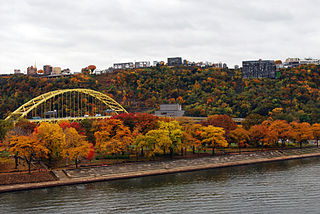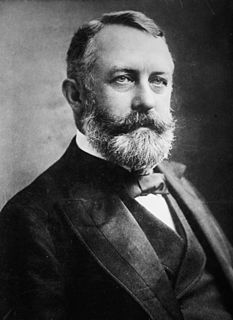
In military science, a blockhouse is a small fortification, usually consisting of one or more rooms with loopholes, allowing its defenders to fire in various directions. It usually refers to an isolated fort in the form of a single building, serving as a defensive strong point against any enemy that does not possess siege equipment or, in modern times, artillery, air force and cruise missiles. A fortification intended to resist these weapons is more likely to qualify as a fortress or a redoubt, or in modern times, be an underground bunker. However, a blockhouse may also refer to a room within a larger fortification, usually a battery or redoubt.
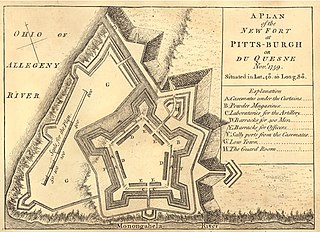
Fort Pitt was a fort built by British forces between 1759 and 1761 during the French and Indian War at the confluence of the Monongahela and Allegheny rivers, where the Ohio River is formed in western Pennsylvania. It was near the site of Fort Duquesne, a French colonial fort built in 1754 as tensions increased between Great Britain and France in both Europe and North America. The French destroyed Fort Duquesne in 1758 when they retreated under British attack.

The Stephen Collins Foster Memorial is a performing arts center and museum which houses the Stephen Foster Archives at the University of Pittsburgh in Pittsburgh, Pennsylvania, USA. It is dedicated to the life and works of American songwriter Stephen Foster.

The William Pitt Union, built in 1898 as the Hotel Schenley, is the student union building of the University of Pittsburgh main campus, and is a Pennsylvania and Pittsburgh History and Landmarks Foundation Historic Landmark. Designed by Pittsburgh-based architects Rutan & Russell in the Beaux-Arts style of architecture, the Schenley Hotel catered to local and visiting well-to-do people. The University of Pittsburgh acquired the property in 1956.
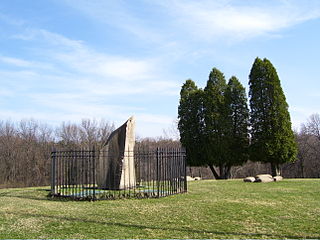
Bushy Run Battlefield Park is a historical park that is operated by the Pennsylvania Historical and Museum Commission (PHMC) and the Bushy Run Battlefield Heritage Society on 218 acres (88 ha) in Penn Township, Westmoreland County, Pennsylvania in the United States. It was the site of the Battle of Bushy Run fought on August 5–6, 1763 during the Pontiac's Rebellion. The battle was a major victory for the British and enabled them to secure their control of the Ohio River Valley and what was to become the Northwest Territory. Bushy Run Battlefield Park was established as a Pennsylvania State Park in the 1920s and became a National Historic Landmark in 1960. The Visitor Center is open Wednesday through Saturday from 9:00 am until 5:00 pm, and Sunday from noon to 5:00 pm, during the months of May–October. The Visitor Center hosts a museum exhibit entitled, "The March to Bushy Run", a theater, a gift shop and battlefield tours. Bushy Run Battlefield Park is the only historic site or museum that deals exclusively with Pontiac's Rebellion. Battle reenactments are held annually on the first full weekend of August. The park is on Pennsylvania Route 993 near Harrison City and Jeannette.

Fort Pitt Museum is an indoor/outdoor museum that is administered by the Senator John Heinz History Center in downtown Pittsburgh, Allegheny County, Pennsylvania in the United States. It is at the confluence of the Monongahela and Allegheny Rivers, where the Ohio River is formed. Fort Pitt Museum is surrounded by Point State Park, a Pennsylvania state park named for the geographically and historically significant point that is between the rivers. This piece of land was key to controlling the upper reaches of the Ohio River Valley and western Pennsylvania, before, during and after the French and Indian War as well as the American Revolution.

Thackeray Hall is an academic building of the University of Pittsburgh and a contributing property to the Schenley Farms National Historic District at 139 University Place on the campus of the University of Pittsburgh in Pittsburgh, Pennsylvania, United States.

The Henry Clay Frick Fine Arts Building is a landmark Renaissance villa and a contributing property to the Schenley Farms-Oakland Civic Historic District on the campus of the University of Pittsburgh in Pittsburgh, Pennsylvania, United States. The Frick Fine Arts Building sits on the southern edge of Schenley Plaza, opposite The Carnegie Institute, and is the home of Pitt's History of Art and Architecture Department, Studio Arts Department, and the Frick Fine Arts Library. Before its front steps is Mary Schenley Memorial Fountain.
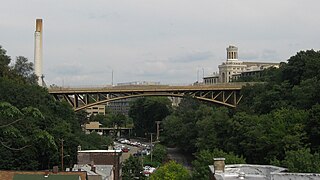
Schenley Bridge connects Schenley Plaza to Schenley Park in Pittsburgh, Pennsylvania. It carries Schenley Drive over Junction Hollow to Frew Street and Flagstaff Hill.

Panther Hollow Bridge carries Wilmot Road over Panther Hollow in Schenley Park in Pittsburgh, Pennsylvania.
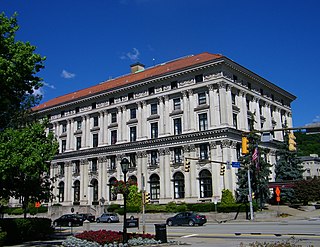
The Pittsburgh Athletic Association is a private social club and athletic club in Pittsburgh, Pennsylvania, USA. Its clubhouse is listed on the National Register of Historic Places.

Bellefield Hall is a Pittsburgh History and Landmarks Foundation Historic Landmark and is a contributing property to the Schenley Farms Historic District on the campus of the University of Pittsburgh across Bellefield Avenue from Heinz Memorial Chapel and the lawn of the university's Cathedral of Learning in Pittsburgh, Pennsylvania, USA. A 1924 italianate structure by architect Benno Janssen, it originally served as a Young Men's and Women's Hebrew Association, but now houses rehearsal spaces, classrooms, offices, and a Digital Recording Studio for the University of Pittsburgh's Department of Music, as well as a university gymnasium, fitness center, indoor swimming pool, and a 676-seat auditorium.

Schenley Quadrangle is a cluster of University of Pittsburgh residence halls that is a Pittsburgh History and Landmarks Foundation Historic Landmark and are contributing properties to the Schenley Farms National Historic District in Pittsburgh, Pennsylvania, United States.
Boquet is an unincorporated community in Penn Township, Westmoreland County, Pennsylvania, United States

The O'Hara Student Center, formerly the Concordia Club, is a three-story, 18,000-square-foot (1,700 m2) building on the campus of the University of Pittsburgh on O'Hara Street in the Oakland neighborhood of Pittsburgh, Pennsylvania. It is a contributing property to the Schenley Farms National Historic District and the City of Pittsburgh Oakland Civic Center Historic District. The building was acquired by the university in mid-December, 2009. and has since been renovated to house academic and student activity programs.
A blockhouse is a small, isolated fort in the form of a single building.
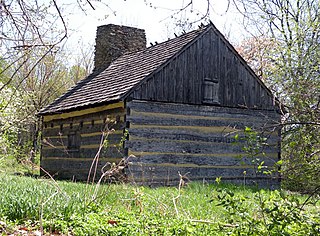
The Neill (Neal) Log House is a historic log cabin built in 1765 in Pittsburgh, Pennsylvania. It is the oldest home in Pittsburgh. The other two oldest buildings in Pittsburgh are not homes. The Old Stone Inn was built in 1756(not confirmed) and The Fort Pitt Block House was built in 1764. The Pittsburgh History and Landmarks Foundation placed a Historic Landmark Plaque on the building in 1970. In 1977, it was named a City of Pittsburgh Designated Historic Structure. It is part of Schenley Park U.S. Historic District

